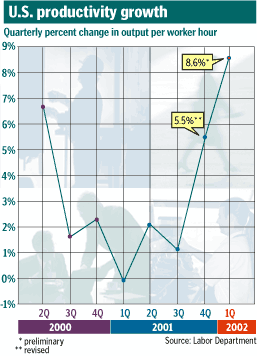
NEW YORK (CNN/Money) -
Strong productivity growth in the United States in the late 1990s was no fluke, a group of economists said recently, and it will help the economy expand without the threat of inflation and let the Federal Reserve keep short-term interest rates lower for longer.
The National Association for Business Economics, in a survey published Monday afternoon, said 90 percent of the 30 economists it surveyed expect productivity to continue to grow, letting gross domestic product (GDP) expand at a rate of about 3.5 percent through the end of 2003 with inflation staying low.
As a result, more than 85 percent of the economists surveyed think the Fed will keep its target for a key short-term interest rate -- already at a 40-year low -- unchanged until the third quarter.
The Fed recently said its current target for the federal funds rate, an overnight bank lending rate that influences the level of other short-term rates, was "accommodative," meaning it was more likely to help the economy grow than fight inflation. The NABE economists said a "neutral" fed funds rate is more likely 3.5 percent, but the Fed could take another year to raise rates to that level.

Driven by new technology, productivity at non-farm businesses grew at an average annual rate of about 2.5 percent between 1996 and 2000, never dipping below 2 percent during that time -- the best uninterrupted stretch of productivity gains since the early 1960s.
During the latest four quarters -- which included a recession that probably began in March 2001 -- productivity grew at an average quarterly rate of 4.3 percent, far better than the average quarterly growth of just 0.15 percent during the four quarters of the 1990-91 recession.
"The remarkably good behavior of productivity during the recession taught us one important lesson," said NABE President Harvey Rosenblum, who is a senior vice president at the Dallas Fed. "Those outsized efficiency gains of the late '90s were not a cyclical or statistical fluke."
Last week, the Labor Department said productivity surged at an 8.6 percent annual rate in the first quarter, the best rate since 9.9 percent in the second quarter of 1983, after growing at a revised 5.5 percent rate in the fourth quarter.
One reason for the strong productivity growth, however, has been a trimming of non-farm payrolls during the latest recession. Businesses shed about 1.5 million jobs last year and will be slow to hire new workers until they're convinced a recovery in the economy -- and corporate profits -- is for real.
| |
 Related links
Related links
| |
| | |
| | |
|
As a result, the unemployment rate is likely to continue to rise for a few months, prompting the Fed to keep interest rates low, keeping the cost of borrowing cheap and freeing up cash for consumer spending, which fuels about two-thirds of the economy.
The economists surveyed were not worried that the economy would sink again into recession, but they acknowledged that sluggish business spending could hinder the strength of the recovery. They expect only 2-percent growth in corporate profits and a 5-percent drop in business spending this year. They do expect both to recover in 2003.

|

